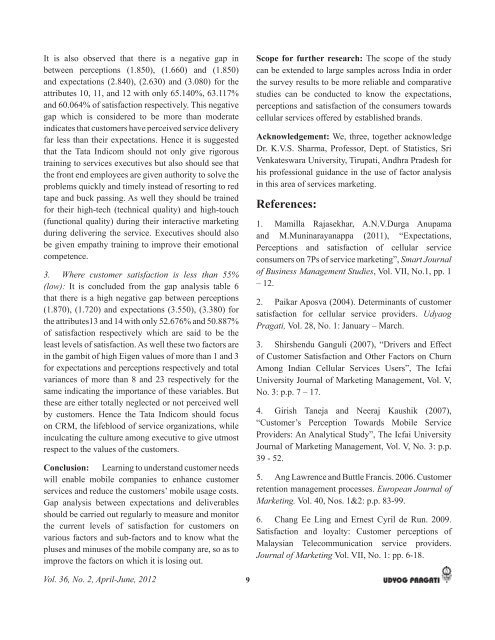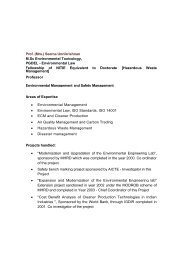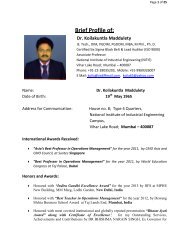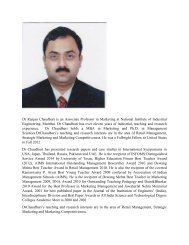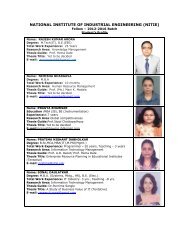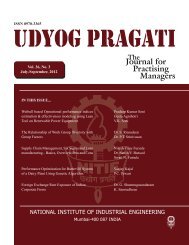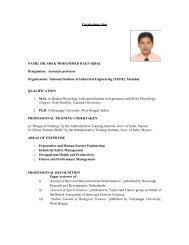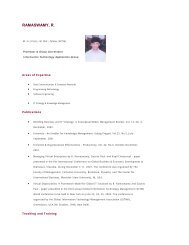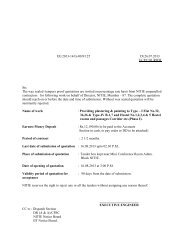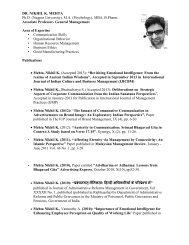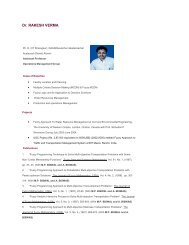Apr-Jun.12 - the Nitie
Apr-Jun.12 - the Nitie
Apr-Jun.12 - the Nitie
You also want an ePaper? Increase the reach of your titles
YUMPU automatically turns print PDFs into web optimized ePapers that Google loves.
It is also observed that <strong>the</strong>re is a negative gap in<br />
between perceptions (1.850), (1.660) and (1.850)<br />
and expectations (2.840), (2.630) and (3.080) for <strong>the</strong><br />
attributes 10, 11, and 12 with only 65.140%, 63.117%<br />
and 60.064% of satisfaction respectively. This negative<br />
gap which is considered to be more than moderate<br />
indicates that customers have perceived service delivery<br />
far less than <strong>the</strong>ir expectations. Hence it is suggested<br />
that <strong>the</strong> Tata Indicom should not only give rigorous<br />
training to services executives but also should see that<br />
<strong>the</strong> front end employees are given authority to solve <strong>the</strong><br />
problems quickly and timely instead of resorting to red<br />
tape and buck passing. As well <strong>the</strong>y should be trained<br />
for <strong>the</strong>ir high-tech (technical quality) and high-touch<br />
(functional quality) during <strong>the</strong>ir interactive marketing<br />
during delivering <strong>the</strong> service. Executives should also<br />
be given empathy training to improve <strong>the</strong>ir emotional<br />
competence.<br />
3. <br />
It is concluded from <strong>the</strong> gap analysis table 6<br />
that <strong>the</strong>re is a high negative gap between perceptions<br />
(1.870), (1.720) and expectations (3.550), (3.380) for<br />
<strong>the</strong> attributes13 and 14 with only 52.676% and 50.887%<br />
of satisfaction respectively which are said to be <strong>the</strong><br />
least levels of satisfaction. As well <strong>the</strong>se two factors are<br />
in <strong>the</strong> gambit of high Eigen values of more than 1 and 3<br />
for expectations and perceptions respectively and total<br />
variances of more than 8 and 23 respectively for <strong>the</strong><br />
<br />
<strong>the</strong>se are ei<strong>the</strong>r totally neglected or not perceived well<br />
by customers. Hence <strong>the</strong> Tata Indicom should focus<br />
on CRM, <strong>the</strong> lifeblood of service organizations, while<br />
inculcating <strong>the</strong> culture among executive to give utmost<br />
respect to <strong>the</strong> values of <strong>the</strong> customers.<br />
Conclusion: <br />
will enable mobile companies to enhance customer<br />
services and reduce <strong>the</strong> customers’ mobile usage costs.<br />
Gap analysis between expectations and deliverables<br />
should be carried out regularly to measure and monitor<br />
<strong>the</strong> current levels of satisfaction for customers on<br />
various factors and sub-factors and to know what <strong>the</strong><br />
pluses and minuses of <strong>the</strong> mobile company are, so as to<br />
improve <strong>the</strong> factors on which it is losing out.<br />
Scope for fur<strong>the</strong>r research: The scope of <strong>the</strong> study<br />
can be extended to large samples across India in order<br />
<strong>the</strong> survey results to be more reliable and comparative<br />
studies can be conducted to know <strong>the</strong> expectations,<br />
perceptions and satisfaction of <strong>the</strong> consumers towards<br />
cellular services offered by established brands.<br />
Acknowledgement: We, three, toge<strong>the</strong>r acknowledge<br />
Dr. K.V.S. Sharma, Professor, Dept. of Statistics, Sri<br />
Venkateswara University, Tirupati, Andhra Pradesh for<br />
his professional guidance in <strong>the</strong> use of factor analysis<br />
in this area of services marketing.<br />
References:<br />
1. Mamilla Rajasekhar, A.N.V.Durga Anupama<br />
and M.Muninarayanappa (2011), “Expectations,<br />
Perceptions and satisfaction of cellular service<br />
consumers on 7Ps of service marketing”, <br />
of Business Management Studies, Vol. VII, No.1, pp. 1<br />
– 12.<br />
2. Paikar Aposva (2004). Determinants of customer<br />
satisfaction for cellular service providers. <br />
Vol. 28, No. 1: January – March.<br />
3. Shirshendu Ganguli (2007), “Drivers and Effect<br />
of Customer Satisfaction and O<strong>the</strong>r Factors on Churn<br />
Among Indian Cellular Services Users”, The Icfai<br />
University Journal of Marketing Management, Vol. V,<br />
No. 3: p.p. 7 – 17.<br />
4. Girish Taneja and Neeraj Kaushik (2007),<br />
“Customer’s Perception Towards Mobile Service<br />
Providers: An Analytical Study”, The Icfai University<br />
Journal of Marketing Management, Vol. V, No. 3: p.p.<br />
39 - 52.<br />
<br />
retention management processes. <br />
Marketing. Vol. 40, Nos. 1&2: p.p. 83-99.<br />
<br />
Satisfaction and loyalty: Customer perceptions of<br />
Malaysian Telecommunication service providers.<br />
Vol. VII, No. 1: pp. 6-18.<br />
Vol. 36, No. 2, <strong>Apr</strong>il-June, 2012<br />
9


